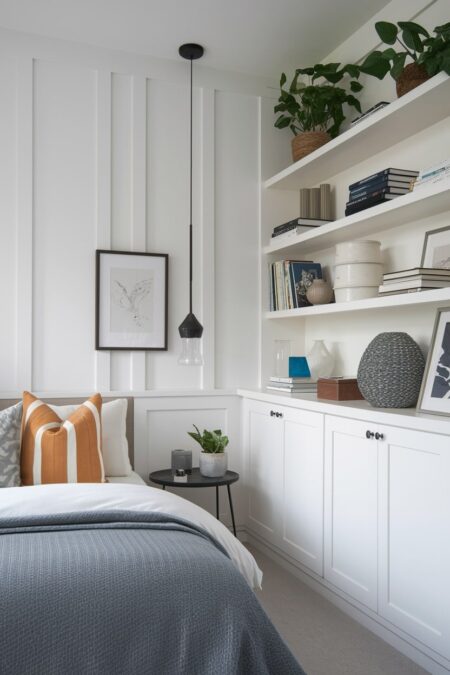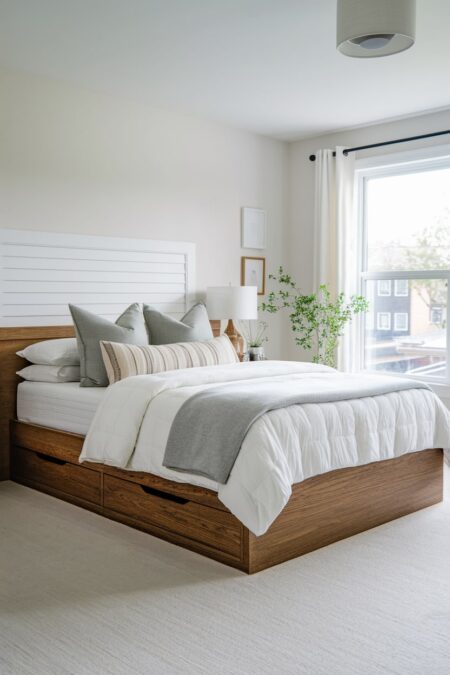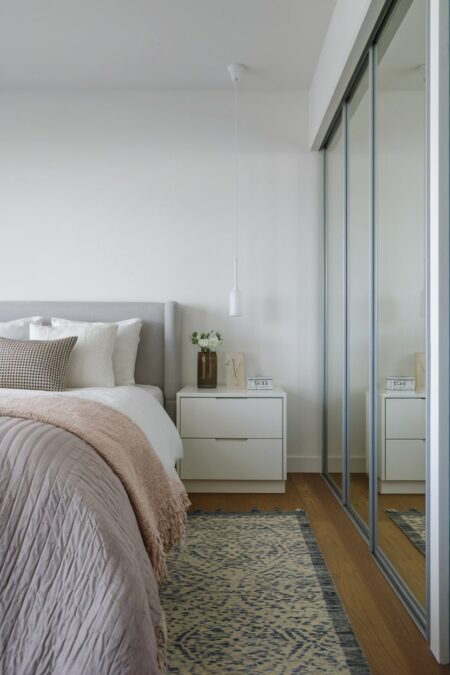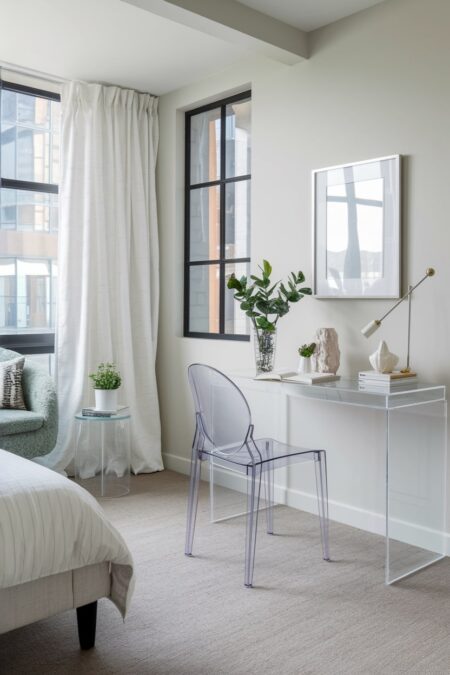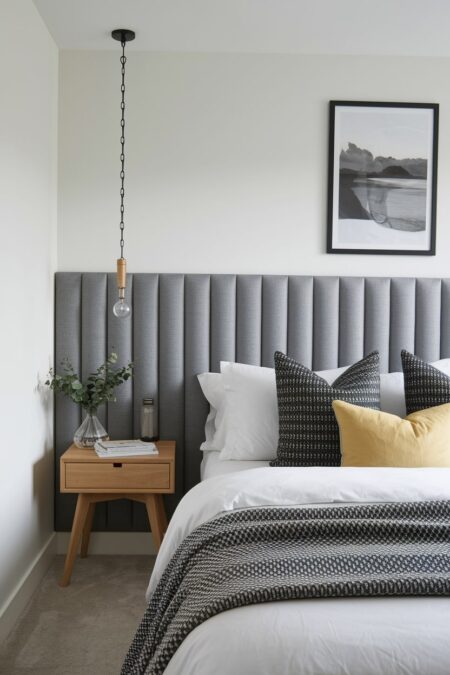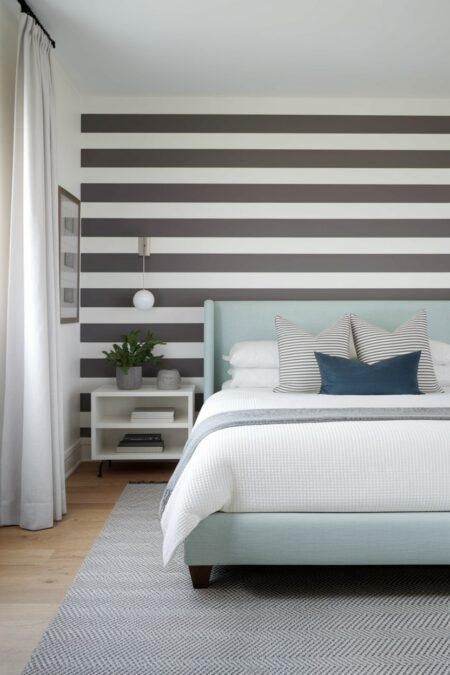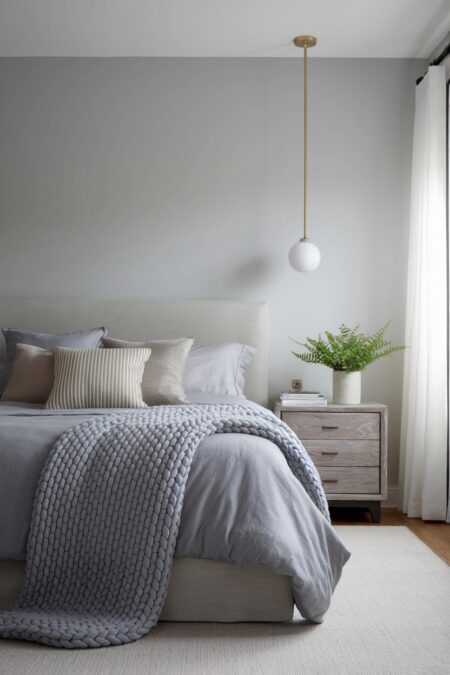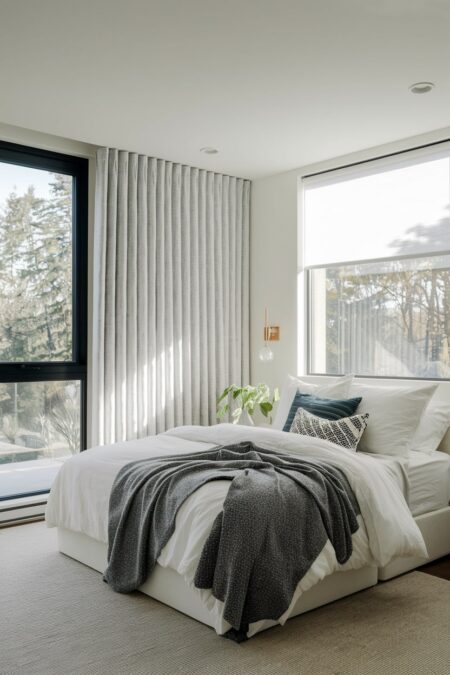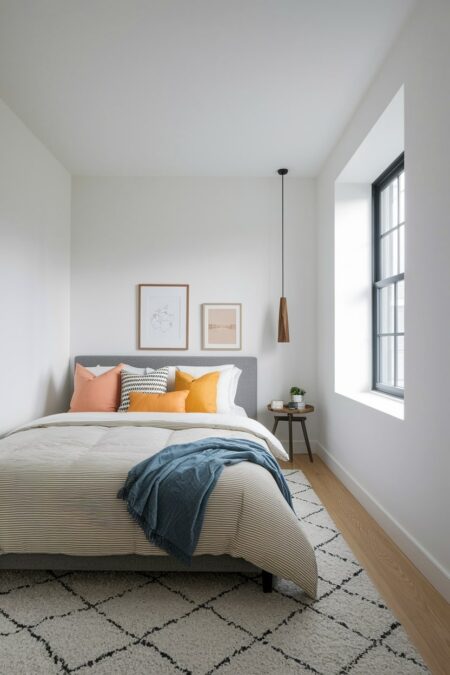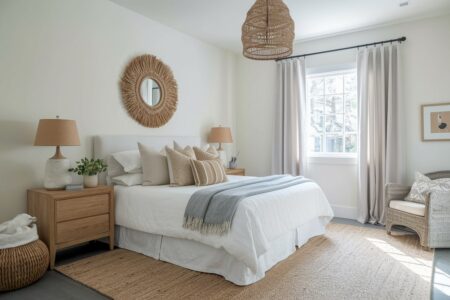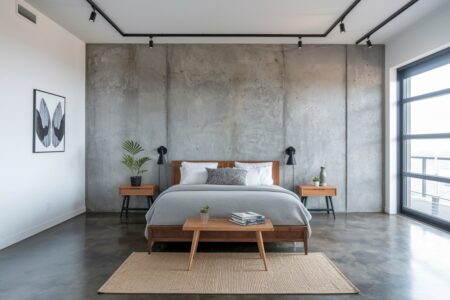A small bedroom doesn’t have to feel cramped or limited. With thoughtful design choices, even the most compact space can transform into a serene and functional retreat. The key is to employ clever strategies that maximize every square inch, create the illusion of spaciousness, and reflect your personal style. From smart furniture selections to strategic color palettes, these ideas will help you unlock the full potential of your small bedroom, turning it into a sanctuary you’ll love spending time in.
-
01 of 18
Embrace Vertical Storage Solutions
When floor space is at a premium, the only way to go is up. Utilizing your walls effectively is one of the most impactful changes you can make in a small bedroom. Think beyond traditional bookcases and consider installing floor-to-ceiling shelving units. This approach draws the eye upward, creating a sense of height and openness. These shelves can house books, decorative items, and stylish storage bins, keeping clutter off the floor and surfaces.
To put this into practice, choose shelving that matches your wall color to create a seamless, built-in look that feels less bulky. For a more modern aesthetic, a modular shelving system allows you to customize the arrangement to fit your specific needs, accommodating everything from clothing to electronics in a single, streamlined unit.
-
02 of 18
Paint with a Light and Airy Palette
Color has a profound effect on how we perceive a space. Dark, saturated hues can make a room feel enclosed and smaller than it is, while light, bright colors do the opposite. Opting for a color palette of soft whites, gentle creams, pale blues, or subtle grays can make your bedroom feel more open and expansive. These colors are excellent at reflecting natural light, which further enhances the sense of spaciousness.
Consider painting the walls, ceiling, and trim in the same light shade. This technique blurs the lines where surfaces meet, tricking the eye into seeing a larger, more cohesive area. If you crave a pop of color, introduce it through smaller accents like throw pillows, artwork, or a single piece of furniture rather than overwhelming the room with a bold wall.
-
03 of 18
Harness the Power of Mirrors
Mirrors are a designer’s secret weapon for small spaces. They create a powerful illusion of depth by reflecting both light and the room itself, effectively making the space feel twice as large. Placing a large mirror on a wall opposite a window is particularly effective, as it will capture the outdoor view and bounce natural light throughout the room, making it feel brighter and more vibrant.
You can make a statement with a large, beautifully framed floor mirror leaned against a wall for a casual yet chic effect. Alternatively, a collection of smaller mirrors arranged in a gallery style can serve as a unique piece of wall art that also expands the room visually. Mirrored closet doors are another brilliant solution, as they serve a dual purpose without taking up any additional wall space.
-
04 of 18
Invest in Under-Bed Storage
The space beneath your bed is often an underutilized asset. Instead of letting it collect dust, turn it into a powerhouse of storage. Many modern bed frames come with built-in drawers, which are perfect for stowing away extra linens, seasonal clothing, or shoes. This keeps items organized and out of sight, contributing to a tidy and uncluttered environment.
If your current bed frame doesn’t have built-in options, you can easily replicate this functionality with rolling bins or storage containers designed to slide underneath. Look for containers with lids to keep the contents protected and dust-free. For a more permanent solution, bed risers can elevate your frame, creating more vertical clearance for larger storage boxes.
-
05 of 18
Choose Floating Furniture
Furniture that appears to “float” creates a sense of openness because it keeps the floor clear, allowing the eye to see more of the available space. Wall-mounted nightstands and floating shelves are excellent examples of this concept. By mounting these pieces directly to the wall, you eliminate the need for legs, which can make a room feel cluttered and visually heavy.
A floating desk can serve as a functional workspace without the bulk of a traditional desk, and it can even double as a vanity. When selecting these pieces, opt for slim profiles and clean lines to maintain a minimalist aesthetic that enhances the feeling of spaciousness.
-
06 of 18
Opt for Multi-Functional Pieces
In a small bedroom, every piece of furniture should earn its keep. Look for items that can serve more than one purpose to maximize functionality without sacrificing space. A storage ottoman, for example, can act as a comfortable seat, a footrest, and a hidden place to store blankets or magazines. A headboard with built-in shelving can replace the need for bedside tables, offering a spot for your book, phone, and a small lamp.
When furnishing your bedroom, always ask if a piece can do double duty. A small writing desk can also function as a makeup vanity, and a bench at the foot of the bed can provide seating and storage. This approach reduces the number of individual furniture items you need, freeing up valuable floor space.
-
07 of 18
Adopt a Minimalist Mindset
Clutter is the enemy of a small space. The more items you have, the more cramped and chaotic your room will feel. Adopting a minimalist approach by decluttering and keeping only the essentials is a transformative step. Go through your belongings and decide what you truly need and love, and find a proper home for everything you decide to keep.
Practice the “one in, one out” rule to maintain a state of balance. Whenever you bring a new item into the room, an old one must go. This prevents the slow accumulation of clutter over time. Keep surfaces like your nightstand and dresser clear, allowing just one or two decorative items to be displayed.
-
08 of 18
Implement Strategic Lighting
Good lighting can make a world of difference in a small bedroom. Traditional table lamps and floor lamps take up valuable surface and floor space. Instead, consider lighting solutions that can be mounted. Wall sconces installed on either side of the bed provide excellent task lighting for reading and free up your nightstands.
A stylish pendant light or a modern chandelier can serve as a beautiful focal point while drawing the eye upward. Make sure to have layered lighting, including ambient (overall), task (for specific activities), and accent lighting. Installing dimmer switches allows you to control the intensity and mood, making the room feel cozy and inviting without being overly bright.
-
09 of 18
Select Appropriately Scaled Furniture
Oversized, bulky furniture can quickly overwhelm a small bedroom. When making your selections, pay close attention to scale. Choose pieces with a smaller footprint and a lighter visual weight. For instance, a bed frame with a low-profile headboard or no headboard at all will feel less imposing than a massive, ornate one.
Look for nightstands and dressers with clean lines and tapered legs, which create a sense of elevation and space underneath. Before you buy, measure your room and the furniture to ensure a comfortable fit, leaving enough room for clear pathways to walk around.
-
10 of 18
Incorporate See-Through Elements
Furniture made from transparent materials like acrylic or lucite is a fantastic choice for small rooms. Because you can see right through them, these pieces have very little visual weight, making them appear to take up almost no space at all. An acrylic chair at a desk or a clear waterfall-style table can provide the function you need without adding visual clutter.
This trick works because the furniture doesn’t obstruct the view of the floor or the wall behind it, maintaining an uninterrupted sightline that helps the room feel more open. You can apply this concept to smaller accessories as well, such as clear storage boxes or transparent lamp bases.
-
11 of 18
Make One Grand Statement
While it may seem counterintuitive, having too many small, decorative items can make a small room feel busy and disorganized. Instead of cluttering your walls with a dozen small frames, opt for one large piece of art. A single, oversized statement piece acts as a powerful focal point, drawing attention and adding a touch of sophistication.
This approach simplifies the visual landscape of the room, making it feel more curated and intentional. The large scale of the art can also trick the eye into perceiving the wall as being larger than it is, contributing to an overall sense of grandeur and openness.
-
12 of 18
Utilize Awkward Corners
Corners are often overlooked and can become dead space in a room. Put these awkward spots to work with furniture designed specifically for them. A corner shelving unit can provide ample storage for books and decor, while a small corner desk can create a compact and efficient workspace.
You can also place a comfortable armchair or a tall plant in a corner to add a cozy reading nook or a touch of nature. By activating these underused areas, you can reclaim valuable real estate and improve the overall flow and functionality of your bedroom.
-
13 of 18
Re-think the Headboard
A traditional headboard can protrude several inches from the wall, eating into the limited length of your bedroom. To save space, consider alternatives. A wall-mounted, upholstered headboard panel provides the comfort and style of a traditional headboard but with a much slimmer profile.
For an even more space-conscious solution, you can create the illusion of a headboard by painting a shape directly onto the wall behind your bed. Another creative idea is to use a decal or arrange a series of decorative panels. These options add a personal touch and a clear focal point without sacrificing any floor space.
-
14 of 18
Hang Curtains High and Wide
The way you hang your curtains can dramatically alter the perception of your room’s size. To make your windows appear larger and your ceilings taller, mount the curtain rod several inches above the window frame (or from the ceiling) and extend it wider than the frame on both sides. This technique draws the eye upward and outward.
When the curtains are open, they will frame the window without blocking any of the glass, allowing the maximum amount of natural light to stream in. Choose lightweight, airy fabrics in a color that is similar to your wall color to maintain a bright and cohesive look, or opt for accent colors.
-
15 of 18
Leverage the Power of Stripes
Patterns can be used strategically to manipulate the perception of space. Vertical stripes, for instance, draw the eye up and down, which can make a room with low ceilings feel taller. This can be achieved through wallpaper on an accent wall or a tall, striped piece of decor like a room screen.
Similarly, horizontal stripes can make a narrow room feel wider. A striped area rug is an excellent way to introduce this effect. When using stripes, it’s best to stick to a simple, two-tone color scheme to avoid overwhelming the space.
-
16 of 18
Create a Monochromatic Scheme in a Small Bedroom
Decorating with a monochromatic color scheme (using various tints, tones, and shades of a single hue) is a sophisticated way to make a small room feel larger and more serene. This approach creates a seamless and harmonious look, where there are no jarring contrasts to break up the space visually. The unified palette helps the room feel uncluttered and peaceful.
To successfully implement a monochromatic look, be sure to incorporate a variety of textures to add depth and interest. For example, in an all-gray bedroom, you could combine a chunky knit blanket, a smooth silk pillow, a linen headboard, and a weathered wood nightstand. These textural differences prevent the design from feeling flat.
-
17 of 18
Maximize Natural Light
Natural light is one of the most effective tools for making any space feel bigger and more inviting. Do everything you can to maximize the amount of daylight that enters your bedroom. Avoid heavy, dark window treatments that block light. Instead, opt for sheer curtains, light-filtering blinds, or simple roller shades that can be pulled up completely during the day.
Keep your windows clean and ensure there is no furniture obstructing them. The goal is to create a bright, sun-drenched space that feels connected to the outdoors, which will inherently make it feel less confined.
-
18 of 18
Position Your Bed Strategically
The placement of your bed, the largest piece of furniture in the small bedroom, has a major impact on the layout and available space. The most common arrangement is to center the bed against the longest wall. However, in a very narrow bedroom, pushing the bed into a corner can be a game-changer. This opens up a significant amount of floor space, creating a more usable area for other activities or furniture.
This “corner bed” layout can create a cozy, nook-like feeling. While it means one person may have to shuffle to get out of bed, the trade-off in open floor space can be well worth it in a tight room. Experiment with different placements to see what configuration best suits your needs and maximizes the room’s potential.

